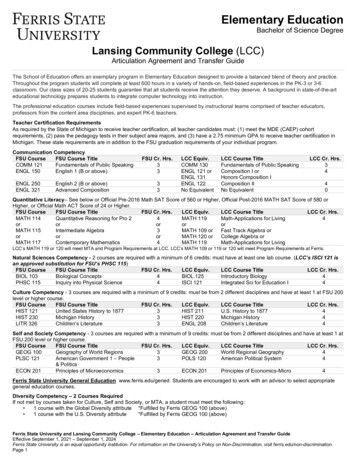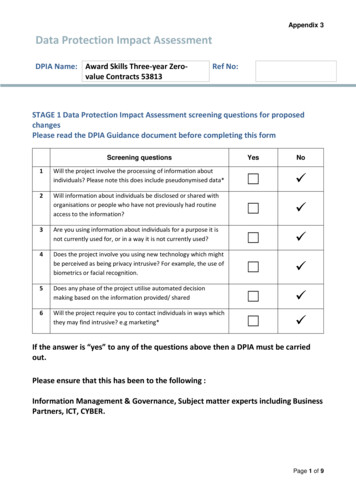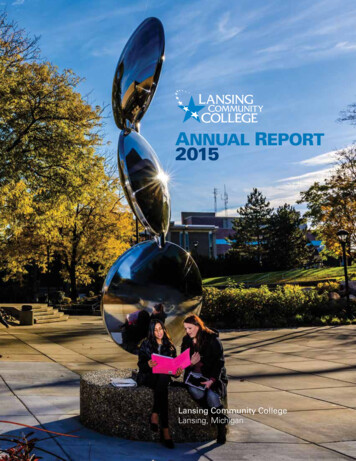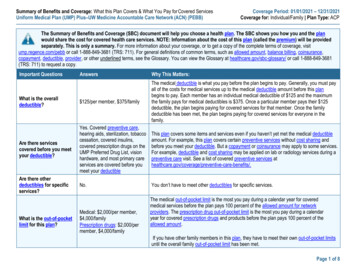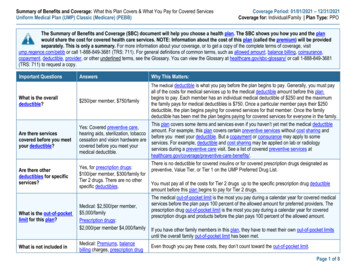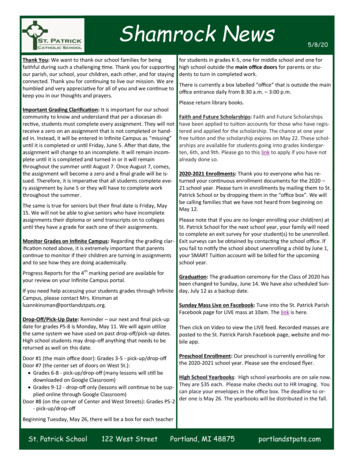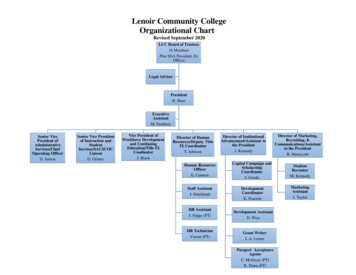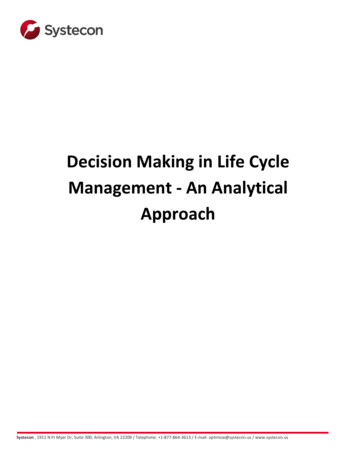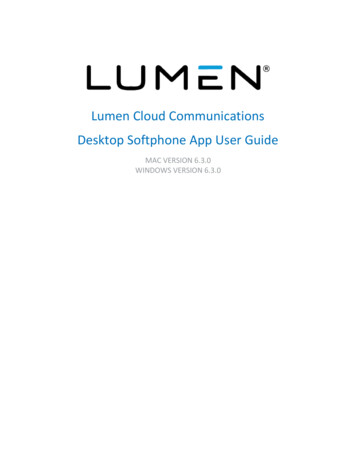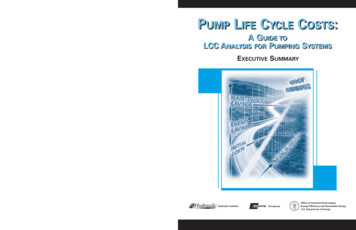
Transcription
PUMP LIFE CYCLE COSTS:A GUIDE TOLCC ANALYSIS FOR PUMPING SYSTEMSEXECUTIVE SUMMARYVisit Hydraulic Institute online at:www.pumps.orgVisit Europump online at:www.europump.orgI CAERAEDI CAEREuropumpGYERuropumpU N ITHydraulic InstituteNT OFMEENRTSTMAT E S OFDEPASTMEDDOE/GO-102001-1190January 2001GYERNT OFMEENRTU N ITuropumpDEPAVisit the U.S. Department of Energy’s Office of Industrial Technologies online at:www.oit.doe.govAT E S OFAOffice of Industrial TechnologiesEnergy Efficiency and Renewable EnergyU.S. Department of Energy
IntroductionPump Life Cycle Costs: A Guide to LCC Analysis for Pumping Systems is the result of acollaboration between the Hydraulic Institute, Europump, and the US Department ofEnergy’s Office of Industrial Technologies (OIT).Table of ContentsImproving Pump System Performance . . . . . . . . . . . . . . . .1What is Life Cycle Cost?. . . . . . . . . . . . . . . . . . . . . . . . . . . .2Why Should Organizations Care about Life Cycle Cost? . . . .3Getting Started . . . . . . . . . . . . . . . . . . . . . . . . . . . . . . . . . .3Life Cycle Cost Analysis . . . . . . . . . . . . . . . . . . . . . . . . . . . .3Pumping System Design . . . . . . . . . . . . . . . . . . . . . . . . . . .9Example:Pumping System with a Problem Control Valve . . . . . . . .12For More Information . . . . . . . . . . . . . . . . . . . . . . . . . . . .16
Executive SummaryImproving Pump System Performance: An OverlookedOpportunity?The life cycle cost(LCC) of any piece ofequipment is the total“lifetime” cost topurchase, install,operate, maintain,and dispose of thatequipment.Pumping systems account for nearly 20% of the world’s electrical energy demand andrange from 25-50% of the energy usage in certain industrial plant operations.Pumping systems are widespread; they provide domestic services, commercial andagricultural services, municipal water/wastewater services, and industrial servicesfor food processing, chemical, petrochemical, pharmaceutical, and mechanicalindustries. Although pumps are typically purchased as individual components,they provide a service only when operating as part of a system. The energy andmaterials used by a system depend on the design of the pump, the design of theinstallation, and the way the system is operated. These factors are interdependent.What’s more, they must be carefully matched to each other, and remain so throughout their working lives to ensure the lowest energy and maintenance costs, equipment life, and other benefits. The initial purchase price is a small part of the lifecycle cost for high usage pumps. While operating requirements may sometimesoverride energy cost considerations, an optimum solution is still possible.A greater understanding of all the components that make up the total cost ofownership will provide an opportunity to dramatically reduce energy, operational,and maintenance costs. Reducing energy consumption and waste also has importantenvironmental benefits.Life Cycle Cost (LCC) analysis is a management tool that can help companiesminimize waste and maximize energy efficiency for many types of systems, includingpumping systems. This overview provides highlights from Pump Life Cycle Costs:A Guide to LCC Analysis for Pumping Systems, developed by the Hydraulic Instituteand Europump to assist plant owners/operators in applying the LCC methodologyto pumping systems. For information on obtaining a copy of the Guide, see page 15of this summary.Initial costsMaintenancecostsTypical life cyclecosts for amedium-sizedindustrial pumpEnergy costsOther costs1
LCC Analysis for Pumping SystemsPumping systemsacount for nearly20% of the world’selectrical energydemand and rangefrom 25-50% of theenergy usage incertain industrialplant operationsIn some industrial plant operations, pumping systems account for 25 to 50% ofenergy use.What is Life Cycle Cost?The life cycle cost (LCC) of any piece of equipment is the total “lifetime” cost topurchase, install, operate, maintain, and dispose of that equipment. DeterminingLCC involves following a methodology to identify and quantify all of thecomponents of the LCC equation.When used as a comparison tool between possible design or overhaul alternatives,the LCC process will show the most cost-effective solution within the limits of theavailable data.The components of a life cycle cost analysis typically include initial costs, installationand commissioning costs, energy costs, operation costs, maintenance and repaircosts, down time costs, environmental costs, and decommissioning and disposalcosts.2
Executive SummaryWhy Should Organizations Care About Life Cycle Cost?Many organizations only consider the initial purchase and installation cost of asystem. It is in the fundamental interest of the plant designer or manager to evaluatethe LCC of different solutions before installing major new equipment or carryingout a major overhaul. This evaluation will identify the most financially attractivealternative. As national and global markets continue to become more competitive,organizations must continually seek cost savings that will improve the profitabilityof their operations. Plant equipment operations are receiving particular attentionas a source of cost savings, especially minimizing energy consumption and plantdowntime.Some studies haveshown that 30% to50% of the energyconsumed by pumpsystems could be savedthrough equipment orcontrol system changesExisting systems provide a greater opportunity for savings through the use of LCCmethods than do new systems for two reasons. First, there are at least 20 times asmany pump systems in the installed base as are built each year; and, second,many of the existing systems have pumps or controls that are not optimized sincethe pumping tasks change over time.Some studies have shown that 30% to 50% of the energy consumed by pumpsystems could be saved through equipment or control system changes.In addition to the economic reasons for using LCC, many organizations arebecoming increasingly aware of the environmental impact of their businesses,and are considering energy efficiency as one way to reduce emissions and preservenatural resources.Getting StartedLCC analysis, either for new facilities or renovations, requires the evaluation ofalternative systems. For a majority of facilities, the lifetime energy and/ormaintenance costs will dominate the life cycle costs. It is therefore important toaccurately determine the current cost of energy, the expected annual energy priceescalation for the estimated life, along with the expected maintenance laborand material costs. Other elements, such as the life time costs of down time,decommissioning, and environmental protection, can often be estimated based onhistorical data for the facility. Depending upon the process, down time costs can bemore significant than the energy or maintenance elements of the equation. Carefulconsideration should therefore be given to productivity losses due to down time.This overview provides an introduction to the life cycle costing process. The completeGuide expands upon life cycle costing and provides substantial technical guidanceon designing new pumping systems as well as assessing improvements to existingsystems. The Guide also includes a sample chart, examples of manual calculationof LCC, and a software tool to assist in LCC calculation.Life Cycle Cost AnalysisIn applying the evaluation process, or in selecting pumps and other equipment,the best information concerning the output and operation of the plant must be3
LCC Analysis for Pumping SystemsThe LCC process is away to predict themost cost-effectivesolution; it does notguarantee a particularresult, but allows theplant designer ormanager to make areasonable comparisonbetween alternatesolutions withinthe limits of theavailable dataestablished. The process itself is mathematically sound, but if incorrect or impreciseinformation is used then an incorrect or imprecise assessment will result. The LCCprocess is a way to predict the most cost-effective solution; it does not guarantee aparticular result, but allows the plant designer or manager to make a reasonablecomparison between alternate solutions within the limits of the available data.Pumping systems often have a lifespan of 15 to 20 years. Some cost elements willbe incurred at the outset and others may be incurred at different times throughoutthe lives of the different solutions being evaluated. It is therefore practicable, andpossibly essential, to calculate a present or discounted value of the LCC in order toaccurately assess the different solutions.This analysis is concerned with assessments where details of the system design arebeing reviewed. Here the comparison is between one pump type and another, orone control means and another. The exercise may be aimed at determining whatscope could be justified for a monitoring or control scheme, or for different processcontrol means to be provided. Whatever the specifics, the designs should becompared on a like-for-like basis. To make a fair comparison, the plant designer/manager might need to consider the measure used. For example, the same processoutput volume should be considered and, if the two items being examined cannotgive the same output volume, it may be appropriate to express the figures in costper unit of output (e.g., /ton, or Euro/kg). The analysis should consider all significantdifferences between the solutions being evaluated.Finally, the plant designer or manager might need to consider maintenance orservicing costs, particularly where these are to be subcontracted, or spare parts areto be provided with the initial supply of the equipment for emergency stand-byprovision. Whatever is considered must be on a strictly comparable basis. If theplant designer or manager decides to subcontract or carry strategic spares basedentirely on the grounds of convenience, this criterion must be used for all systemsbeing assessed. But, if it is the result of maintenance that can be carried out only bya specialist subcontractor then its cost will correctly appear against the evaluationof that system.Elements of theLCC equation LCC Cic Cin Ce Co Cm Cs Cenv CdLCC life cycle costCic initial costs, purchase price (pump, system, pipe, auxiliary services)Cin installation and commissioning cost (including training)Ce energy costs (predicted cost for system operation, including pump driver,controls, and any auxiliary services)Co operation costs (labor cost of normal system supervision)Cm maintenance and repair costs (routine and predicted repairs)Cs down time costs (loss of production)Cenv environmental costs (contamination from pumped liquid and auxiliaryequipment)Cd decommissioning/disposal costs (including restoration of the localenvironment and disposal of auxiliary services).The following sections examine each element and offer suggestions on how a realisticvalue can be determined for use in computing the LCC. It should be noted that thiscalculation does not include the raw materials consumed by the plant in making aproduct.4
Executive SummaryCic - Initial Investment CostsThe pump plant designer or manager must decide the outline design of the pumpingsystem. The smaller the pipe and fitting diameters, the lower the cost of acquiring andinstalling them. However, the smaller diameter installation requires a more powerfulpump resulting in higher initial and operating costs. In addition, smaller pipe sizeson the inlet side of a pump will reduce the net positive suction head available (NPSHA),thus requiring a larger and slower speed pump, which will typically be more expensive.Provisions must be made for the acceleration head needed for positive displacementpumps or the depth of submergence needed for a wet pit pump.There will be other choices, which may be made during the design stage that can affectinitial investment costs. One important choice is the quality of the equipment beingselected. There may be an option regarding materials having differing wear rates,heavier duty bearings or seals, or more extensive control packages, all increasing theworking life of the pump. These and other choices may incur higher initial costsbut reduce LCC costs.The initial costs will also usually include the following items: engineering (e.g. design and drawings, regulatory issues)the bid processpurchase order administrationtesting and inspectioninventory of spare partstrainingauxiliary equipment for cooling and sealing waterCin - Installation and Commissioning (Start-up) CostsInstallation and commissioning costs include the following: foundations—design, preparation, concrete and reinforcing, etc.setting and grouting of equipment on foundationconnection of process pipingconnection of electrical wiring and instrumentationconnection of auxiliary systems and other utilitiesprovisions for flushing or ‘water runs’performance evaluation at start-upInstallation can be accomplished by an equipment supplier, contractor, or by userpersonnel. This decision depends on several factors, including the skills, tools, andequipment required to complete the installation; contractual procurement requirements; work rules governing the installation site; and the availability of competentinstallation personnel. Plant or contractor personnel should coordinate sitesupervision with the supplier. Care should be taken to follow installation instructionscarefully. A complete installation includes transfer of equipment operation andmaintenance requirements via training of personnel responsible for system operation.Commissioning requires close attention to the equipment manufacturer’s instructionfor initial start-up and operation. A checklist should be used to ensure that equipmentand the system are operating within specified parameters. A final sign offtypically occurs after successful operation is demonstrated.5
LCC Analysis for Pumping SystemsCe - Energy CostsEnergy consumptionis often one of thelarger cost elementsand may dominate theLCC, especially ifpumps are runmore than 2000 hoursper yearEnergy consumption is often one of the larger cost elements and may dominate theLCC, especially if pumps run more than 2000 hours per year. Energy consumptionis calculated by gathering data on the pattern of the system output. If output issteady, or essentially so, the calculation is simple. If output varies over time, then atime-based usage pattern needs to be established.The input power calculation formula is:P Q x H x s.g.366 x ηp x ηmP Q x H x s.g.3960 x ηp x ηmwhere: P[kW] (metric)[hp] (U.S. units) powerQ rate of flow, m3/hr (US gpm)H head, m (ft.)ηp ηm pump efficiencymotor efficiencys.g. specific gravityThe plant designer or manager needs to obtain separate data showing the performanceof each pump/system being considered over the output range. Performance can bemeasured in terms of the overall efficiencies of the pump unit or of the energiesused by the system at the different output levels. Driver selection and applicationwill affect energy consumption. For example, much more electricity is required todrive a pump with an air motor than with an electric motor. In addition, someenergy use may not be output dependent. For example, a control system sensingoutput changes may itself generate a constant energy load, whereas a variablespeed electric motor drive may consume different levels of energy at differentoperating settings. The use of a throttling valve, pressure relief, or flow by-pass forcontrol will reduce the operating efficiency and increase the energy consumed.The efficiency or levels of energy used should be plotted on the same time base asthe usage values to show their relationship to the usage pattern. The area underthe curve then represents the total energy absorbed by the system being reviewedover the selected operating cycle. The result will be in kWh (kilowatt-hours). Ifthere are differential power costs at different levels of load, then the areas must betotaled within these levels.Once the charge rates are determined for the energy supplied, they can be appliedto the total kWh for each charge band (rate period). The total cost of the energyabsorbed can then be found for each system under review and brought to acommon time period.Finally, the energy and material consumption costs of auxiliary services need to beincluded. These costs may come from cooling or heating circuits, from liquid flushlines, or liquid/gas barrier arrangements. For example, the cost of running a coolingcircuit using water will need to include the following items: cost of the water, boosterpump service, filtration, circulation, and heat extraction/dissipation.6
Executive SummaryMaintenance and repair is a significant component of pumping system life cyclecosts and an effective maintenance program can minimize these costs.Co - Operation CostsObtaining optimumworking life from apump requires regularand efficient servicingOperation costs are labor costs related to the operation of a pumping system. Thesevary widely depending on the complexity and duty of the system. For example, ahazardous duty pump may require daily checks for hazardous emissions, operationalreliability, and performance within accepted parameters. On the other hand, a fullyautomated non-hazardous system may require very limited supervision. Regularobservation of how a pumping system is functioning can alert operators to potentiallosses in system performance. Performance indicators include changes in vibration,shock pulse signature, temperature, noise, power consumption, flow rates, and pressure.Cm - Maintenence and Repair CostsObtaining optimum working life from a pump requires regular and efficientservicing. The manufacturer will advise the user about the frequency and the extentof this routine maintenance. Its cost depends on the time and frequency of serviceand the cost of materials. The design can influence these costs through the materialsof construction, components chosen, and the ease of access to the parts to beserviced.The cost of unexpecteddowntime and lostproduction is a verysignificant item in thetotal LCC and can rivalthe energy costsand replacement partscosts in its impactThe maintenance program can be comprised of less frequent but more majorattention as well as the more frequent but simpler servicing. The major activitiesoften require removing the pump to a workshop. During the time the unit isunavailable to the process plant, there can be loss of product or a cost from atemporary replacement. These costs can be minimized by programming majormaintenance during annual shut-down or process change-over. Major service canbe described as “pump unit not reparable on site,” while the routine work isdescribed as “pump unit reparable on site.”7
LCC Analysis for Pumping SystemsThe total cost of routine maintenance is found by multiplying the costs per event bythe number of events expected during the life cycle of the pump.Although unexpected failures cannot be predicted precisely, they can be estimatedstatistically by calculating mean time between failures (MTBF). MTBF can be estimatedfor components and then combined to give a value for the complete machine.It might be sufficient to simply consider best and worst case scenarios where theshortest likely life and the longest likely lifetimes are considered. In many cases,plant historical data is available.The manufacturer can define and provide MTBF of the items whose failure willprevent the pump unit from operating or will reduce its life expectancy below thedesign target. These values can be derived from past experience or from theoreticalanalyses. The items can be expected to include seals, bearings, impeller/valve/portwear, coupling wear, motor features, and other special items that make up thecomplete system. The MTBF values can be compared with the design working lifeof the unit and the number of failure events calculated.It must be recognized that process variations and user practices will almost certainlyhave a major impact upon the MTBF of a plant and the pumps incorporated in it.Whenever available, historical data is preferable to theoretical data from theequipment supplier. The cost of each event and the total costs of these unexpectedfailures can be estimated in the same way that routine maintenance costs arecalculated.Cs - Downtime and Loss of Production CostsThe cost of unexpected downtime and lost production is a very significant itemin the total LCC and can rival the energy costs and replacement parts costs in itsimpact. Despite the design or target life of a pump and its components, there willbe occasions when an unexpected failure occurs. In those cases where the cost oflost production is unacceptably high, a spare pump may be installed in parallel toreduce the risk. If a spare pump is used, the initial cost will be greater but the costof unscheduled maintenance will include only the cost of the repair.The cost of lost production is dependent on downtime and differs from case to case.Cenv - Environmental Costs, Including Disposal of Partsand Contamination from Pumped LiquidThe cost of contaminant disposal during the lifetime of the pumping system variessignificantly depending on the nature of the pumped product. Certain choices cansignificantly reduce the amount of contamination, but usually at an increasedinvestment cost. Examples of environmental contamination can include: coolingwater and packing box leakage disposal; hazardous pumped product flare-off;used lubricant disposal; and contaminated used parts, such as seals. Costs forenvironmental inspection should also be included.Cd - Decommissioning/Disposal Costs, IncludingRestoration of the Local EnvironmentIn the vast majority of cases, the cost of disposing of a pumping system will varylittle with different designs. This is certainly true for non-hazardous liquids and,in most cases, for hazardous liquids also. Toxic, radioactive, or other hazardous8
Executive Summaryliquids will have legally imposed protection requirements, which will be largely thesame for all system designs. A difference may occur when one system has thedisposal arrangements as part of its operating arrangements (for example, a hygienicpump designed for cleaning in place) while another does not (for example, ahygienic pump designed for removal before cleaning). Similar arguments can beapplied to the costs of restoring the local environment. When disposal is veryexpensive, the LCC becomes much more sensitive to the useful life of the equipment.Total Life Cycle CostsProper pumpingsystem design is themost important singleelement in minimizingthe LCCThe costs estimated for the various elements making up the total life cycle costsneed to be aggregated to allow a comparison of the designs being considered. Thisis best done by means of a tabulation which identifies each item and asks for avalue to be inserted. Where no value is entered, an explanatory comment shouldbe added. The estimated costs can then be totaled to give the LCC values forcomparison, and attention will also be drawn to non-qualitative evaluation factors.There are also financial factors to take into consideration in developing the LCC.These include: present energy prices expected annual energy price increase (inflation) during the pumpingsystem life time discount rate interest rate expected equipment life (calculation period)In addition, the user must decide which costs to include, such as maintenance,down time, environmental, disposal, and other important costs.Pumping System DesignBy developing amodel of the pipingsystem, one can easilyconsider systemalternatives, but themodel must firstbe validated to insurethat it accuratelyrepresents theoperating pipingsystem it is trying toemulateProper pumping system design is the most important single element in minimizingthe LCC. All pumping systems are comprised of a pump, a driver, pipe installation,and operating controls, and each of these elements is considered individually. Properdesign considers the interaction between the pump and the rest of the system andthe calculation of the operating duty point(s). The characteristics of the pipingsystem must be calculated in order to determine required pump performance. Thisapplies to both simple systems as well as to more complex (branched) systems.Both procurement costs and operational costs make up the total cost of an installationduring its lifetime. A number of installation and operational costs are directlydependent on the piping diameter and the components in the piping system.A considerable amount of the pressure losses in the system are caused by valves, inparticular control valves in throttle-regulated installations. In systems with severalpumps, the pump workload is divided between the pumps, which together, and inconjunction with the piping system, deliver the required flow.The piping diameter is selected based on the following factors: economy of the whole installation (pumps and system) required lowest flow velocity for the application (e.g., avoid sedimentation) required minimum internal diameter for the application (e.g., solids handling)9
LCC Analysis for Pumping Systems maximum flow velocity to minimize erosion in piping and fittings plant standard pipe diametersDecreasing the pipeline diameter has the following effects: Piping and component procurement and installation costs will decrease. Pump installation procurement costs will increase as a result of increasedflow losses with consequent requirements for higher head pumps and largermotors. Costs for electrical supply systems will therefore increase. Operating costs will increase as a result of higher energy usage due toincreased friction losses.Some costs increase with increasing pipeline size and some decrease. Because ofthis, an optimum pipeline size may be found, based on minimizing costs over thelife of the system.The duty point of the pump is determined by the intersection of the system curveand the pump curve as shown in Figure 1.HPump curveHeadSystemcurveFigure 1.The duty pointis the intersectionbetween the pumpand system curvesDuty pointStaticheadRate of flowQA pump application might need to cover several duty points, of which the largestflow and/or head will determine the rated duty for the pump. The pump user mustcarefully consider the duration of operation at the individual duty points to properlyselect the number of pumps in the installation and to select output control.Many software packages are currently available which make it easier to determinefriction losses and generate system curves. Most pump manufacturers can recommendsoftware suitable for the intended duty. Different programs may use different methodsof predicting friction losses and may give slightly different results. Very often suchsoftware is also linked to pump-selection software from that particular manufacturer.Methods for Analyzing Existing Pumping SystemsThe following steps provide an overall guideline to improve an existing pumpingsystem. Assemble a complete document inventory of the items in the pumping system.Determine the flow rates required for each load in the system.Balance the system to meet the required flow rates of each load.Minimize system losses needed to balance the flow rates.Affect changes to the pump to minimize excessive pump head in thebalanced system. Identify pumps with high maintenance cost.10
Executive SummaryOne of two methods can be used to analyze existing pumping systems. One consistsof observing the operation of the actual piping system, and the second consists ofperforming detailed calculations using fluid analysis techniques. The first methodrelies on observations of the operating piping system (pressures, differential pressures,and flow rates), the second deals with creating an accurate mathematical model ofthe piping system and then calculating the pressures and flow rates within the model.Observing the operating system allows one to view how the actual system is working,but system operational requirements limit the amount of experimentation thatplant management will allow. By developing a model of the piping system, one caneasily consider system alternatives, but the model must first be validated to insurethat it accurately represents the operating piping system it is trying to emulate.Regardless of the method used, the objective is to gain a clear picture of how thevarious parts of the system operate and to see where improvements can be madeand the system optimized.The following is a checklist of some useful means to reduce the Life Cycle Costof a pumping system. Consider all relevant costs to determine the Life Cycle CostProcure pumps and systems using LCC considerationsOptimize total cost by considering operational costs and procurement costsConsider the duration of the individual pump duty pointsMatch the equipment to the system needs for maximum benefitMatch the pump type to the intended dutyDon’t oversize the pumpMatch the driver type to the intended dutySpecify motors to be high efficiencyMatch the power transmission equipment to the intended dutyEvaluate system effectivenessMonitor and sustain the pump and system to maximize benefitConsider the energy wasted using control valvesUtilize auxiliary services wiselyOptimize preventative maintenanceMaintain the internal pump clearancesFollow available guidelines regarding the rewinding of motorsAnalyze existing pump systems for improvement opportunitiesUse the showcases in the Guide as a source for ideas11
LCC Analysis for Pumping SystemsExample: Pumping System with a Problem ControlValveIn this example the Life Cycle Cost analysis for the piping system is directed at acontrol valve. The system is a single pump circuit that transports a process fluidcontaining some solids from a storage tank to a pressurized tank. A heat exchangerheats the fluid, and a control valve regulates the ra
A Guide to LCC Analysis for Pumping Systems,developed by the Hydraulic Institute and Europump to assist plant owners/operators in applying the LCC methodology to pumping systems. For information on obtaining a copy of the Guide, see page 15 of this summary. 1 Executive Summary Initial costs Energy costs Other costs Maintenance costs Typical .

